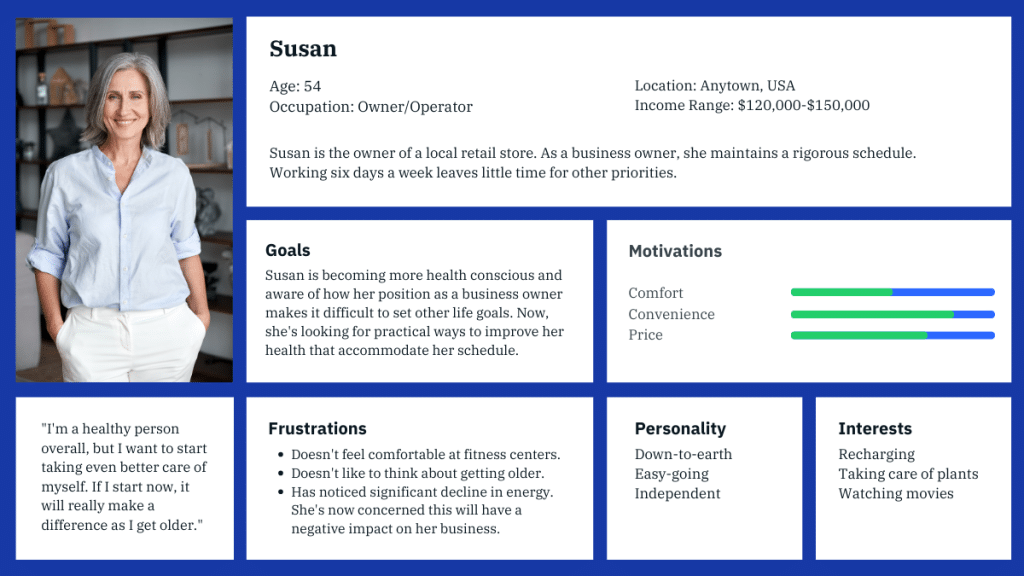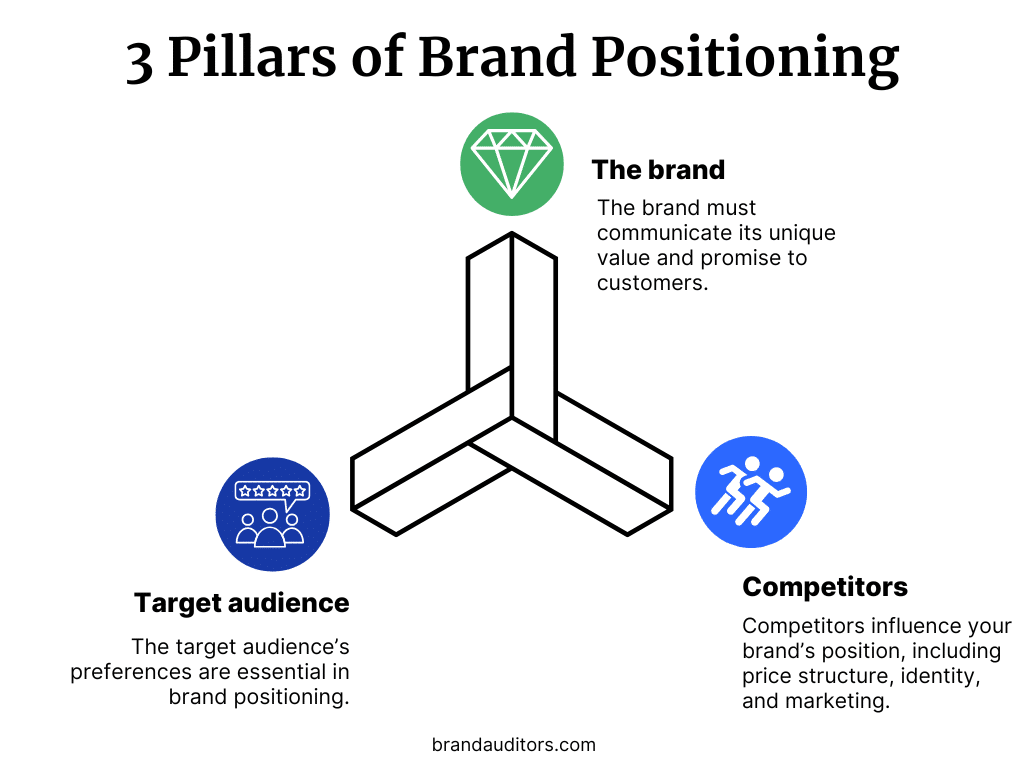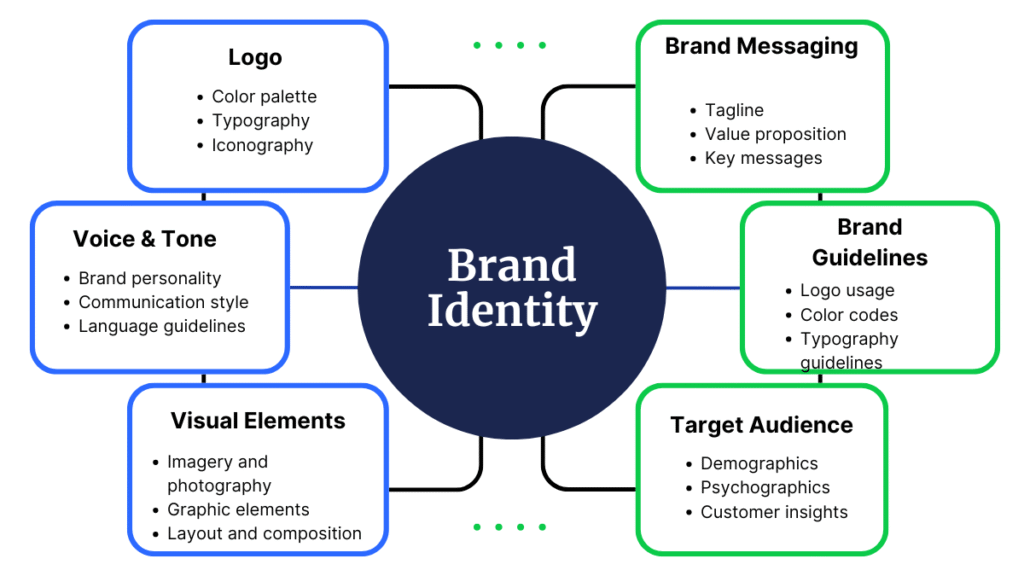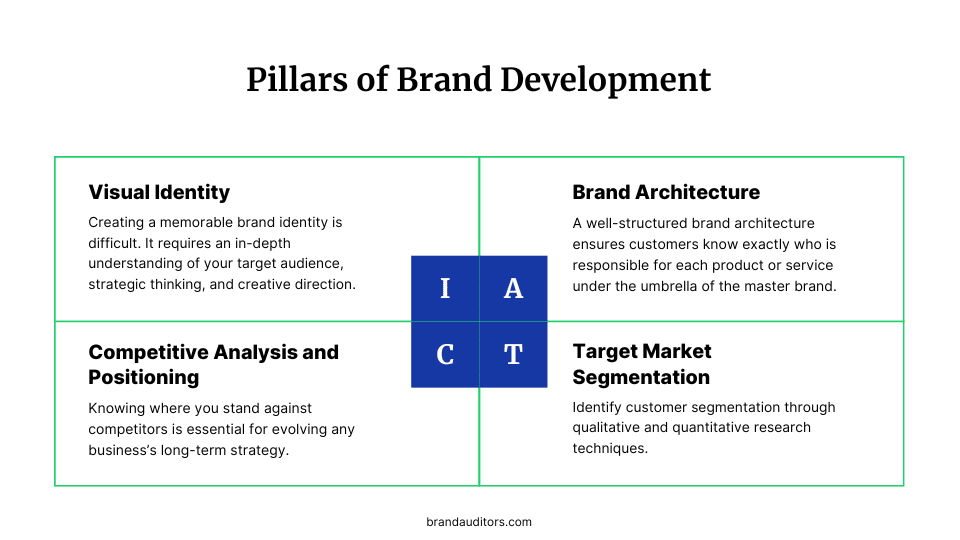An Authentic Brand Development Process for Future-Proof Brands
The brand development process covers brand identity, target audience, and effective brand building for a memorable brand identity that resonates.
October 24, 2025

Do you need a strategic brand development process?
Let’s find out.
You’ve got great products, loyal customers, and an active marketing strategy. But prospects struggle to see how you’re different from competitors.
Marketing feels scattered. There’s no consistent message because you haven’t landed on one that grabs attention.
The sales team struggles to convey your value to customers. Despite your quality and expertise, you’re still competing on price.
These are signs that a business hasn’t strategically positioned its brand. The inconsistencies are adding up and taking a toll. It’s also becoming an expensive problem. Sales are lower than expected, even with increased acquisition costs.
If this sounds familiar, then this post is a must-read.
A data-driven, consistent brand strategy creates advantages competitors can’t copy.
A well-developed brand is a strong brand-one that commands premium prices, inspires customer loyalty, and creates lasting business value.
Brand development isn’t just for large corporations. Companies like MailChimp and Shopify proved that you don’t need Fortune 500 resources to build a powerful brand.
READ MORE: Premium Brand Development: A Framework for Business Leaders
What the brand development process is-and isn’t.
Brand development isn’t branding.
The branding process focuses on visual and creative elements like logos, color palettes, and imagery.
A successful brand development strategy encompasses the entire brand journey, including research, strategy, identity creation, implementation, and ongoing management, all tied to the overall business strategy.
Think of development as building a house, not just decorating it.
To build a brand, you need a solid foundation, a clear blueprint, and constant maintenance to keep everything working.
This process has tremendous business value. Strong brands have customer loyalty and pricing power. They can differentiate themselves more easily from competitors. Premium brands build higher equity over time, becoming valuable assets that can outlive products and business models.
Successful brand strategy development starts with market research
Brand building requires an understanding of the market landscape.
Market analysis has several components, but the first is consumer research. Here, you learn about consumers’ attributes and desires, and how and where they look for your product or service.
Winning customers has never been easy. But given today’s complex customer journeys, developing superior customer experiences is more difficult than ever.
To get the granular customer data needed for effective brand development, companies should move beyond basic demographics and explore psychographics, needs, pain points, and aspirations.
Detailed customer personas bring your target audience to life and guide the brand image. The more you know about your buyers, the easier it will be to develop attention-grabbing marketing campaigns.

Let’s look at an example. A boutique fitness studio might conduct market research to find that its core audience craves community and accountability, as well as workouts. The business could then tap into those psychographic needs with brand messaging on its website, social media, and marketing materials.
Market research helps strategists learn about competitors. Key aspects of competitor analysis include differentiation opportunities and understanding customer responses through competitor ads, social media, and websites.
A regional accounting firm might analyze how other firms position themselves and discover an opportunity to emphasize innovation and technology solutions for growing businesses.
The internal audit
An internal audit of your organization completes your foundational research. During an internal audit, you’ll need to assess your company’s vision, values, culture, strengths, and weaknesses.
A thorough brand audit can help you understand your brand’s market recognition and perception, as well as what’s working internally and what isn’t.
Crafting a brand development strategy
With the research phase complete, it’s time to develop your brand strategy. In this step, you’ll design a plan for how your company will achieve the desired new brand positioning.
The brand positioning statement
It’s helpful to begin with the positioning statement. This statement should clearly articulate your target segment, value proposition, and differentiation from competitors.
A good positioning statement typically follows this structure: For [target audience], [brand name] is the [category/market] that [key benefit/differentiator] because [reason to believe].
One illustration for a fictional company:
“For busy urban professionals who value health and convenience, GreenPrep is the meal preparation service that delivers chef-crafted, organic meals tailored to individual dietary preferences because we combine locally-sourced ingredients with AI-powered personalization technology and registered dietitian oversight.”
This positioning statement:
- Clearly identifies the target audience (busy urban professionals)
- Names the category (meal preparation service)
- States the key differentiators (chef-crafted, organic, tailored meals)
- Provides concrete reasons to believe (local ingredients, AI technology, dietitian oversight)
The positioning statement becomes the North Star for the entire process, guiding future brand decisions.
READ MORE: How to Position a Brand

The brand promise
Next, define your brand promise to meet customer expectations. It should also be meaningful, deliverable, and aligned with customer needs.
Trader Joe’s has built its business around clear promises. The company’s commitment to unique products at everyday prices, backed by a friendly shopping experience, guides all marketing efforts, from product selection to store design.
Brand architecture
Brand architecture determines how products and services relate to each other and the parent brand. Approaches include monolithic, endorsed brands, or house of brands.
Each model has advantages depending on your business structure and market strategy.
READ MORE: A Business Leader’s Guide to Brand Architecture Optimization
The brand personality
Your brand voice and tone deserve special consideration.
- Will it be serious and professional or rebellious and irreverent?
- Will you speak in a formal or casual tone?
These decisions should match your audience’s preferences and your organization’s character.
A consistent persona and tone build brand recognition and trust.
Consider a financial advisory firm serving young professionals. To attract customers, the company might adopt a conversational, educational tone that demystifies investing rather than the formality traditional firms use.
Creating your brand identity and guidelines
The brand identity brings your strategy out of the style guide and into life-visually and verbally.
The human brain processes images 60,000 times faster than text, making visuals an incredibly powerful tool for quickly grabbing attention.
In this step of the development process, branding comes into play.
An identity includes fundamental elements like your brand name, logo, and tagline. But it also extends to the color palette, brand voice, communication channels, and imagery—all of which must suit your market.
Visual identity usage is critical. Companies that maintain consistency in their communications exude professionalism, expertise, and trust. Studies show that 33% of businesses report that brand consistency helps them boost revenue by 20% or more.
Guidelines provide instructions for maintaining consistency. They should cover logo usage, color specifications, photography style, and graphic treatments.
The more detailed and accessible your guidelines, the easier it is to maintain brand consistency as teams grow and touchpoints multiply.

READ MORE: Perform a Visual Audit to Differentiate Your Brand
Implementing brand guidelines across touchpoints
With the identity established, teams need to deploy it across all brand touchpoints.
Traditional collateral, such as business cards, letterhead, packaging, and signage, is an important physical expression of the brand. Each piece should reinforce your visual and verbal identity while serving its practical purpose.
A specialty food company, for example, should consider how packaging becomes a critical brand touchpoint on retail shelves, communicating quality and values to customers.
Digital tools and platforms require special attention. Websites serve as your digital headquarters and should be a model example of your brand.
Mobile apps, digital templates, and social media assets all need careful design to maintain consistency while adapting to different platform requirements.
The content marketing strategy ties all these pieces together, but messaging must remain coherent across every channel.
READ MORE: The Nuances of Premium Brand Design
The internal brand
Internal branding is often overlooked, but that’s a mistake. Employees are your most important brand ambassadors. They need to understand the brand strategy, believe in the brand promise, and know how to represent the brand in their daily work.
Internal launch events, training materials, and ongoing communication help to build alignment and consistency.
Take Zappos, for example. The company famously invests heavily in internal culture and brand training to make sure every employee delivers on their customer service promise, regardless of their role. Zappos puts every new hire through a four-week training program on company values and offers a “quitting bonus” if the employee doesn’t feel aligned with the culture.
Customer experience is where brand strategy meets reality. Every interaction a customer has with your business—from initial awareness through purchase and beyond—should reflect the brand promise.
Mapping these customer journey touchpoints is the key to designing intentional experiences that are consistent and build a positive brand reputation.
READ MORE: Conducting a Brand Standards Audit to Ensure Consistency
Launching your brand successfully
A launch plan helps your new or updated brand make the greatest possible impact.
First, you’ll need to decide between a phased rollout—one that gradually introduces changes—and a big-bang launch that debuts everything at once. Each approach has merit depending on your situation, resources, and market dynamics.
A phased rollout lets you test and refine while managing costs. This approach is ideal for companies with limited budgets or complex customer bases.
A full launch creates excitement and clarity, but requires more coordination and investment.
An internal launch should precede the external one. Before going public, all teams should understand and embrace the brand. The internal pre-launch includes training sessions, marketing, and opportunities for employees to ask questions and give feedback. This also gives employees an opportunity to contribute to brand development.
The external launch requires careful planning and coordination across multiple channels. Not every brand operates on the same channels, but the most common are public relations, marketing, advertising, service, and events. These channels should work together to create awareness and generate excitement.
Your communication plan should specify key messages, target audiences, timing, and success metrics. Feedback mechanisms are also important to have because they provide the organization with a system for monitoring reception and making adjustments.
Managing and evolving your brand over time
Brand development is an ongoing process that doesn’t end at launch.
Successful brands stay relevant thanks to ongoing management and evolution. Brand monitoring helps you track important metrics and key performance indicators. Examples include quantitative measures such as brand awareness, consideration, and preference, as well as qualitative assessments of brand perception and associations.
Regular surveys, social media listening, and customer feedback analysis also help you assess the brand’s market performance.
Regular brand health “checkups” keep it relevant and resonant. These are important because markets and competitors evolve. So do customer expectations.
Your brand must adapt while maintaining its core consistency. Sometimes this means minor refreshes that update visual elements or messaging. Other times, it requires substantial rebranding to address significant market changes or business pivots.
Dunkin’: A rebrand case study

In this section, we’ll quickly review a case study of the brand management process in a rebranding project.
Dunkin’ dropped “Donuts” from the name to reflect its evolution into a beverage-led brand. However, the company maintained its core identity and loyal customer base.
The Dunkin’ rebrand had several positive financial outcomes:
- Increased revenue: In 2018, Dunkin’s annual revenue surpassed $1.0 billion, reaching $1.27 billion for the first time in the brand’s history. Its expanded coffee menu largely contributed to this growth. By 2019, revenues increased to $1.37 billion.
- Higher profit margins: Menu innovation, particularly in beverages, helped Dunkin’ increase profit margins, as beverages typically yield higher returns than traditional food items.
- Positive stock market reaction: Dunkin’ stock rose after the September 2018 rebranding announcement, initially from $72.98 to $73.79. Within a year, it surged to $80.01, and four years later, it peaked at $106.50 a share, indicating a prolonged positive influence from the rebranding.
- Acquisition value: Inspire Brands acquired Dunkin’ in 2020 for $11.3 billion, underscoring the brand’s increased value following its strategic pivot.
- Enhanced customer loyalty and digital engagement: The rebranding, coupled with digital transformation initiatives such as a revamped mobile app and loyalty program, improved customer retention and drove online sales. Dunkin’ secured the #1 spot for customer loyalty in the out-of-home coffee category.
Brand extensions
Brand extensions represent another ongoing consideration for development.
As your business grows, you decide to introduce new products or enter new markets under your established brand. Done well, brand extensions leverage existing equity and speed up growth.
Done poorly, it can dilute brand meaning and confuse customers.
The key is to ensure the new offerings align with the core brand values and positioning. A successful landscaping company might expand into outdoor living design, but would risk brand dilution by adding unrelated services like pest control.
Brand consistency becomes more challenging as you scale across geographies, product lines, and channels. Systems and governance structures can preserve brand integrity while allowing appropriate flexibility.
Avoiding common pitfalls and following best practices
Several common mistakes can derail brand development efforts.
Weak positioning that doesn’t differentiate or resonate with ideal customers wastes resources and confuses everyone in the market.
Inconsistent application of the brand identity undermines recognition and dilutes brand value. The lack of internal buy-in means employees won’t champion the brand, which creates a disconnect between what the company promises and what it delivers.
Managing the tension between creativity and strategy takes a conscious effort. Beautiful design means nothing without a strategic foundation. A brilliant strategy fails without compelling creative execution.
The best in brand development balances both. They use creativity to bring strategy to life in ways that captivate audiences. Working with brand agencies or consultants who understand this balance helps avoid purely aesthetic rebrands that lack strategic grounding.
Brand dilution happens when companies extend their brand too far or inconsistently. Every time you use your brand name on something that doesn’t align with core values or positioning, you weaken its meaning.
Being disciplined about what carries your brand and how it’s presented protects long-term equity. A premium chocolate maker, for example, would risk diluting its brand by launching a budget line, even if a market opportunity exists. A move like this could contradict the current perception of quality and craftsmanship.
Rebranding carries particular risks. You’re asking customers to adjust their perceptions and associations. Clear communication about why you’re changing and what remains constant helps make these transitions easier. Gradually introducing additional elements can reduce any disruption.
Companies that rebrand successfully maintain the core essence of the brand while updating expressions to stay relevant. When Weight Watchers became WW and moved toward overall wellness rather than just weight loss, they were able to keep their supportive community intact while modernizing the brand for changing consumer attitudes
Preparing for the future of brand development
Brand development continues to evolve alongside technology and culture. Digital and experience-first branding reflects how customers now primarily interact through screens and digital touchpoints.
Brands must create compelling experiences across websites, apps, social media, and other popular platforms. But they must be diligent about maintaining consistency and strategic clarity.
In 2023 and 2024, Glossier, a beauty and skincare brand, reinvented itself by expanding into immersive physical retail spaces. The plan was to make a strategic shift from its digital-only roots.
These new stores, launched in major cities, blend social interaction with product discovery, offering a tactile extension of the brand’s online experience. Glossier also deepened its presence on platforms like TikTok and Instagram, using viral content and creator partnerships to drive engagement and sales. This hybrid model-combining experiential retail with social commerce-reflects Glossier’s evolution into a modern beauty powerhouse.
Brand as a platform
The concept of “brand as platform” represents a shift from brands selling products to brands enabling communities and ecosystems.
Companies like Peloton have embraced this through apps and services that connect members beyond just selling bikes. This approach promotes deeper customer relationships and creates new sources of value and differentiation.
A mid-market company, for example, might create user communities, educational content, or complementary services that keep customers engaged between purchases.
Personal branding and founder-led branding are growing in importance, especially for small businesses and professional services. Founders like Gary Vaynerchuk at VaynerMedia and Yvon Chouinard at Patagonia have become inseparable from their company brands.
Personal branding builds authenticity and connection. But it also requires careful management as companies scale and outlive their founders. For smaller companies, founder visibility can accelerate brand growth by giving the business a relatable face.
Voice search, artificial intelligence assistants, and semantic search using large language models are changing how customers discover and interact with brands.
Brand managers must now consider how brands appear in knowledge graphs, how they’re described by AI assistants, and how they rank in entity-based searches. To do this, marketers and brand managers must focus on earned media, consistent information across platforms, and strong semantic language practices.
Local businesses especially need to ensure their brand information is accurate across Google Business, review sites, and directory listings.

Taking action on your brand development journey
The brand development process requires commitment, resources, and patience. You’re building something meant to last and grow more valuable over time.
Your next steps depend on where you are in your brand journey. If you’re starting from scratch, begin with research and strategy. Resist the temptation to jump straight to logo design without having a strategic foundation.
If you have an established brand, conduct a brand audit to assess current health and identify opportunities for differentiation and growth. An audit may also reveal that your brand has drifted from its original positioning or that market changes require an update.
If you’re considering a rebrand, ensure you have a strategic rationale for any changes and prepare thoroughly before implementing them.
Resources can help guide your journey. Books by David Aaker and Kevin Lane Keller provide foundational knowledge on increasing brand equity and strategic brand management.
Brand strategy frameworks and tools help structure your thinking and keep teams aligned throughout the process. Many successful mid-market companies also work with brand consultants or agencies who bring expertise and objectivity to the process.
Contact The Brand Auditors to start your brand development journey today. Don’t let inconsistencies hold you back. Build a premium brand that commands loyalty and drives value.
Ready to grow your brand?
Connect with a strategist to uncover your biggest opportunities and map out a clear path forward.

POST AUTHOR
Core services
Digital marketing
audit services
Discover how to improve marketing campaigns, strengthen the impact of every customer touchpoint, and focus resources on the actions that generate more revenue.
Customer experience strategy consulting
Turn raw customer data into audience personas and laser-focused messaging.
